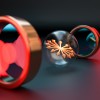
Fast optoelectronic charge state conversion of silicon vacancies in diamond
M. Rieger, V. Villafañe, L. M. Todenhagen, S. Matthies, S. Appel, M. S. Brandt, K. Müller, J. J. Finley
Science Advances 10 (8), eadl4265 (2024).
Group IV vacancy color centers in diamond are promising spin-photon interfaces with strong potential for applications in photonic quantum technologies. Reliable methods for controlling and stabilizing their charge state are urgently needed for scaling to multiqubit devices. Here, we manipulate the charge state of silicon vacancy (SiV) ensembles by combining luminescence and photocurrent spectroscopy. We controllably convert the charge state between the optically active SiV- and dark SiV2- with megahertz rates and >90% contrast by judiciously choosing the local potential applied to in-plane surface electrodes and the laser excitation wavelength. We observe intense SiV- photoluminescence under hole capture, measure the intrinsic conversion time from the dark SiV2- to the bright SiV- to be 36.4(67) ms, and demonstrate how it can be enhanced by a factor of 105 via optical pumping. Moreover, we obtain previously unknown information on the defects that contribute to photoconductivity, indicating the presence of substitutional nitrogen and divacancies.

The Role of Electrolytes in the Relaxation of Near-Surface Spin Defects in Diamond
F. A. Freire-Moschovitis, R. Rizzato, A. Pershin, M. R. Schepp, R. D. Allert, L. M. Todenhagen, M. S. Brandt, A. Gali, D. B. Bucher
Acs Nano 17 (11), 10474-10485 (2023).
Quantum sensing with spin defectsin diamond, such asthe nitrogenvacancy (NV) center, enables the detection of various chemical specieson the nanoscale. Molecules or ions with unpaired electronic spinsare typically probed by their influence on the NV center'sspin relaxation. Whereas it is well-known that paramagnetic ions reducethe NV center's relaxation time (T (1)), here we report on the opposite effect for diamagnetic ions. Wedemonstrate that millimolar concentrations of aqueous diamagneticelectrolyte solutions increase the T (1) timeof near-surface NV center ensembles compared to pure water. To elucidatethe underlying mechanism of this surprising effect, single and doublequantum NV experiments are performed, which indicate a reduction ofmagnetic and electric noise in the presence of diamagnetic electrolytes.In combination with ab initio simulations, we proposethat a change in the interfacial band bending due to the formationof an electric double layer leads to a stabilization of fluctuatingcharges at the interface of an oxidized diamond. This work not onlyhelps to understand noise sources in quantum systems but could alsobroaden the application space of quantum sensors toward electrolytesensing in cell biology, neuroscience, and electrochemistry.

Manganese doping for enhanced magnetic brightening and circular polarization control of dark excitons in paramagnetic layered hybrid metal-halide perovskites
T. Neumann, S. Feldmann, P. Moser, A. Delhomme, J. Zerhoch, T. van de Goor, S. Wang, M. Dyksik, T. Winkler, J.J. Finley, P. Plochocka, M.S. Brandt, C. Faugeras, A.V. Stier, F. Deschler
Nature Communications 12, 3489 (2021).
Materials combining semiconductor functionalities with spin control are desired for the advancement of quantum technologies. Here, we study the magneto-optical properties of novel paramagnetic Ruddlesden-Popper hybrid perovskites Mn:(PEA)2PbI4 (PEA = phenethylammonium) and report magnetically brightened excitonic luminescence with strong circular polarization from the interaction with isolated Mn2+ ions. Using a combination of superconducting quantum interference device (SQUID) magnetometry, magneto-absorption and transient optical spectroscopy, we find that a dark exciton population is brightened by state mixing with the bright excitons in the presence of a magnetic field. Unexpectedly, the circular polarization of the dark exciton luminescence follows the Brillouin-shaped magnetization with a saturation polarization of 13% at 4 K and 6 T. From high-field transient magneto-luminescence we attribute our observations to spin-dependent exciton dynamics at early times after excitation, with first indications for a Mn-mediated spin-flip process. Our findings demonstrate manganese doping as a powerful approach to control excitonic spin physics in Ruddlesden-Popper perovskites, which will stimulate research on this highly tuneable material platform with promise for tailored interactions between magnetic moments and excitonic states.

Echo Trains in Pulsed Electron Spin Resonance of a Strongly Coupled Spin Ensemble
S. Weichselbaumer, M. Zens, C. W. Zollitsch, M. S. Brandt, S. Rotter, R. Gross, H. Hübl
Physical Review Letters 125 (13), 137701 (2020).
We report on a novel dynamical phenomenon in electron spin resonance experiments of phosphorus donors. When strongly coupling the paramagnetic ensemble to a superconducting lumped element resonator, the coherent exchange between these two subsystems leads to a train of periodic, self-stimulated echoes after a conventional Hahn echo pulse sequence. The presence of these multiecho signatures is explained using a simple model based on spins rotating on the Bloch sphere, backed up by numerical calculations using the inhomogeneous Tavis-Cummings Hamiltonian.

Anisotropic Magnetic Resonance in Random Nanocrystal Quantum Dot Ensembles
A.J.S. Almeida, A. Sahu, D.J. Norris, G.N. Kakazei, M.S. Brandt, M. Stutzmann, R.N. Pereira
ACS Omega 5, 11333 (2020).
Magnetic anisotropy critically determines the utility of magnetic nanocrystals (NCs) in new nanomagnetism technologies. Using angular-dependent electron magnetic resonance (EMR), we observe magnetic anisotropy in isotropically arranged NCs of a nonmagnetic material. We show that the shape of the EMR angular variation can be well described by a simple model that considers magnetic dipole–dipole interactions between dipoles randomly located in the NCs, most likely due to surface dangling bonds. The magnetic anisotropy results from the fact that the energy term arising from the magnetic dipole–dipole interactions between all magnetic moments in the system is dominated by only a few dipole pairs, which always have an anisotropic geometric arrangement. Our work shows that magnetic anisotropy may be a general feature of NC systems containing randomly distributed magnetic dipoles.

Thermal characterization of thin films via dynamic infrared thermography
A. Greppmair, N. Galfe, K. Amend, M. Stutzmann, M.S. Brandt
Review of Scientific Instruments 90, 44903 (2019).
We extend the infrared thermography of thin materials for measurements of the full time response to homogeneous heating via illumination. We demonstrate that the thermal conductivity, the heat capacity, as well as the thermal diffusivity can be determined comparing the experimental data to finite difference simulations using a variety of test materials such as thin doped and undoped silicon wafers, sheets of steel, as well as gold and polymer films. We show how radiative cooling during calibration and measurement can be accounted for and that the effective emissivity of the material investigated can also be measured by the setup developed.

Measurements and atomistic theory of electron g-factor anisotropy for phosphorus donors in strained silicon
M. Usman, H. Huebl, A.R. Stegner, C.D. Hill, M.S. Brandt, L.C.L. Hollenberg
Physical Review B 98, 35432 (2018).
This work reports the measurement of electron g-factor anisotropy (|Δg|=|g001−g1¯10|) for phosphorous donor qubits in strained silicon (sSi = Si/Si1−xGex) environments. Multimillion-atom tight-binding simulations are performed to understand the measured decrease in |Δg| as a function of x, which is attributed to a reduction in the interface-related anisotropy. For x<7%, the variation in |Δg| is linear and can be described by ηxx, where ηx≈1.62×10−3. At x=20%, the measured |Δg| is 1.2±0.04×10−3, which is in good agreement with the computed value of 1×10−3. When strain and electric fields are applied simultaneously, the strain effect is predicted to play a dominant role on |Δg|. Our results provide useful insights on the spin properties of sSi:P for spin qubits, and more generally for devices in spintronics and valleytronics areas of research.
